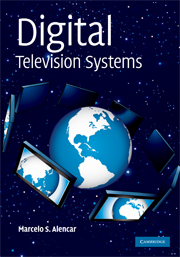Book contents
- Frontmatter
- Contents
- List of figures
- List of tables
- List of contributors
- Preface
- Acknowledgments
- 1 Fundamentals of digital television
- 2 Audio and video coding
- 3 Fundamentals and standards of video and audio compression
- 4 Channel coding for digital television
- 5 Digital and analog transmission systems
- 6 Advanced Television Systems Committee standard (ATSC)
- 7 Digital video broadcasting (DVB)
- 8 International Services Digital Broadcasting for Terrestrial Television Broadcasting (ISDB)
- 9 International System for Digital Television (ISDTV)
- 10 Digital terrestrial television multimedia broadcasting (DTMB)
- Appendix A Evolution of television standards
- Appendix B Signal analysis
- Appendix C Random signals and noise
- Glossary
- References
- Index
2 - Audio and video coding
Published online by Cambridge University Press: 28 January 2010
- Frontmatter
- Contents
- List of figures
- List of tables
- List of contributors
- Preface
- Acknowledgments
- 1 Fundamentals of digital television
- 2 Audio and video coding
- 3 Fundamentals and standards of video and audio compression
- 4 Channel coding for digital television
- 5 Digital and analog transmission systems
- 6 Advanced Television Systems Committee standard (ATSC)
- 7 Digital video broadcasting (DVB)
- 8 International Services Digital Broadcasting for Terrestrial Television Broadcasting (ISDB)
- 9 International System for Digital Television (ISDTV)
- 10 Digital terrestrial television multimedia broadcasting (DTMB)
- Appendix A Evolution of television standards
- Appendix B Signal analysis
- Appendix C Random signals and noise
- Glossary
- References
- Index
Summary
Introduction
Digital television signals are usually generated by cameras, when captured from reallife footage, or are produced by computer animation. In either case, there is a need for coding the source signal. Analog to digital conversion is necessary in the first case, in order to reduce the entropy of the information source. The original analog signal has an infinite number of levels, which implies an infinite storage space in the camera or studio equipment. For the second case, coding is also needed to compress the original signal for transmission.
Digital television typically generates audio and video signals, as well as the data for controlling the broadcasting and for interactivity. The audio and video signals, after being captured by the camera, are processed by a piece of equipment generically known as a source encoder. The source encoder turns the analog signal captured into a digital signal either for storage in a mass memory device, such as the hard disk (HD) or digital video disk (DVD), or for direct broadcasting to the studio.
The analysis of any communication system, including television, reveals that, roughly speaking, the systems may be represented as shown in Figure 2.1, the blocks of which are defined as follows:
Source: this generates the information to be transmitted. The following are examples of output sources: a computer terminal, a microphone, a television camera, and a remote sensor in a telemetry system. The source is commonly modeled by a stochastic signal or by a random data generator to be transmitted.
[…]
- Type
- Chapter
- Information
- Digital Television Systems , pp. 25 - 43Publisher: Cambridge University PressPrint publication year: 2009



